
Revell 1/32 FW-190F-8
| KIT #: | 04869-039 |
| PRICE: | $29.95 SRP |
| DECALS: | Two options |
| REVIEWER: | Tom Cleaver |
| NOTES: |

| HISTORY |
The fighter bomber versions of the Fw 190A began with the Fw 190A 4/U4, which was modified to carry both a 250 lb SC 500 bomb as well as two 66 gal drop tanks under the wings. The Fw 190F was developed from this as a short range dedicated battlefield ground attack aircraft, while the Fw 190G was developed as a long range fighter bomber.
Limited numbers of Fw 190Fs were created from early Fw 190A 4 and A 5 airframes, with the major production version being the Fw 190F 8 developed from the Fw 190A 8. The Fw 190 F 8 appeared in March, 1944. It differed from the Fw 190A 8 by being equipped with a modified injector on the compressor which allowed for increased performance at lower altitudes for several minutes. Additionally, the Fw 190F 8 was equipped with the improved FuG 16 ZS radio unit, which allowed much better communication with ground combat units.
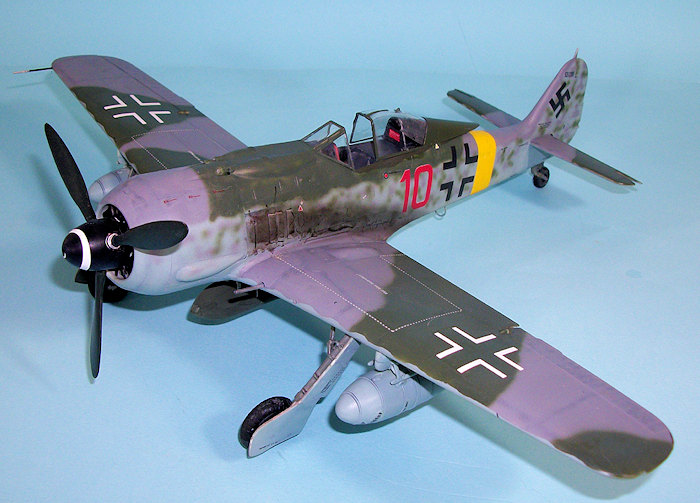 Armament of
the Fw 190 F 8 was restricted to two MG 151/20 20mm cannon in the wing roots and
two MG 131 machine guns mounted in the fuselage above the engine. According to
official records, at least 3,400 F 8s were built, a greater number than the Fw 190A 8,
as of December 1944. Several hundred more were likely produced between February
to May 1945, though the records are missing.
Armament of
the Fw 190 F 8 was restricted to two MG 151/20 20mm cannon in the wing roots and
two MG 131 machine guns mounted in the fuselage above the engine. According to
official records, at least 3,400 F 8s were built, a greater number than the Fw 190A 8,
as of December 1944. Several hundred more were likely produced between February
to May 1945, though the records are missing.
The Fw 190F 8 faced at least as much ground opposition as did the P 47 Thunderbolt used as a fighter bomber. However, while the American fighter was produced in such numbers that it was easy for a unit to write off a damaged airframe and obtain a new replacement, the Luftwaffe was forced to rebuild damaged airframes in order to maintain replacements. The service was able to do this due to the high standards of training for Luftwaffe mechanics and technical service personnel, which was much more complete than that given their Allied counterparts, and gave them the ability to do this sort of major depot work in the field when they had the time. This cannibalization of damaged airframes is shown in the many photographs of Fw 190Fs where the camouflage of major subassemblies is different enough to display the fact that the airplane photographed was rebuilt from wrecks, often from more than one to get one serviceable airplane.
The prime user of the Fw 190F on the Eastern Front was Schlachtgeschwader 2. II/SG 2, formerly II/SchlG 1, converted to the Fw 190F beginning in late 1942, while I/SG 2 kept on using older Bf 109Es and Ju 87s until they converted to the new Fw 190F in June 1944. III/SG 2 continued to use the obsolete Ju 87D until the end of the war.
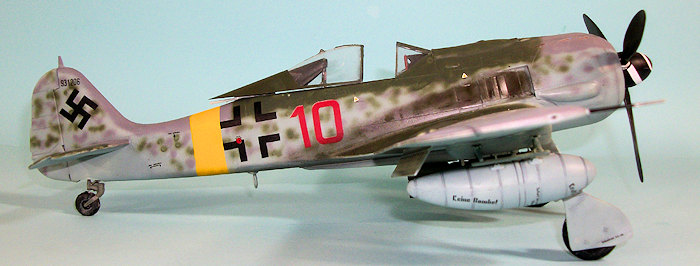 As one of
only two FW 190 equipped
Schlachtgruppen
on the Eastern Front, II/SG 2 was heavily involved in the Crimean campaign
during the first half of 1944. While II/JG 52 was tasked with providing air
cover, the
Schlachtflieger
also flew numerous interception sorties and claiming 247 Soviet aircraft shot
down during the campaign. Leutnant August Lambert claimed 70 kills during one 3
week period.
As one of
only two FW 190 equipped
Schlachtgruppen
on the Eastern Front, II/SG 2 was heavily involved in the Crimean campaign
during the first half of 1944. While II/JG 52 was tasked with providing air
cover, the
Schlachtflieger
also flew numerous interception sorties and claiming 247 Soviet aircraft shot
down during the campaign. Leutnant August Lambert claimed 70 kills during one 3
week period.
By May, 1944, the depleted II/SG 2 retired to Romania. Following the Romanian surrender in late August, which was followed by a declaration of war on Germany, the Luftwaffe units in the country made a fighting withdrawal into Hungary in late September. The winter campaign in Hungary and Slovakia was hard fought, with heavy losses on both sides. The Fw 190Fs were always outnumbered by Soviet ground attack aircraft, and their bases were constantly under attack.
By April, 1945, Slovakia had been liberated and the Geschwader Stab and II/SG 2 were based at Kummer, in northern Bohemia, with I/SG 2 in Austria, and III/SG 2 outside Prague. With only limited fuel supplied and few aircraft, SG 2 continued supporting the retreat of Wehrmacht forces.
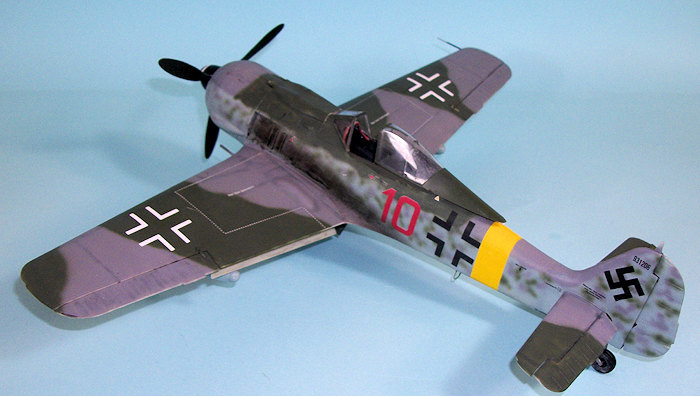 On 8 May
1945, facing capture by the Soviets, Oberst Rudel, Kommodore of SG2, decided to
try to reach Western Germany in order to surrender to the Western Allies. Rudel
led the three Ju 87s and four FW 190s still operational on a flight to the USAAF
airfield at Kitzingen. The rest of the unit formed a truck convoy which would
travel west. Before they could make their escape, the ground column was later
attacked by Soviet Stormoviks with the survivors then attacked a few hours later
by roving American fighter bombers. With all equipment destroyed, there were
only a few survivors, all of whom were captured by the Soviets.
On 8 May
1945, facing capture by the Soviets, Oberst Rudel, Kommodore of SG2, decided to
try to reach Western Germany in order to surrender to the Western Allies. Rudel
led the three Ju 87s and four FW 190s still operational on a flight to the USAAF
airfield at Kitzingen. The rest of the unit formed a truck convoy which would
travel west. Before they could make their escape, the ground column was later
attacked by Soviet Stormoviks with the survivors then attacked a few hours later
by roving American fighter bombers. With all equipment destroyed, there were
only a few survivors, all of whom were captured by the Soviets.
The leading ace of SG 2 was August Lambert, a former Stuka pilot who became a Luftwaffe fighter ace, Following his 70th victory in the Crimea, he was awarded the Knight's Cross of the Iron Cross. By April, 1945, Lambert’s score was 116, an indication of just how heavy the fighting was during the retreat on the southern front. On the morning of April 17, 1945, Lambert, Leutnant Gerhard Bauer, and another pilot were taking off from Kamenz on a ground attack mission when P 51Ds of the 55th Fighter Group appeared over the field. Bauer's FW 190 F 9 was quickly shot down north of Kuckau, 8 kilometers ESE of Kamenz. Lambert and his wingman tried desperately to get away, but could not lose their pursuers. Lambert was shot down just north of Hoyerswerda, 20 km NNE of Kamenz, and his airplane exploded on impact.
| THE KIT |
Revell’Germany’s Fw-190F-8 is the second kit of this sub-type to appear in 1/32 scale, the first being from Hasegawa in their Fw-190 series. Tamiya also released an F-8 in 1/48. This is another in Revell’s series of 1/32 scale kits “designed to a price.” While it’s good news that the Revell kit is one-third the current price of a 1/32 Hasegawa Fw-190, there are certain tell-tale signs of its “low budget” origins.
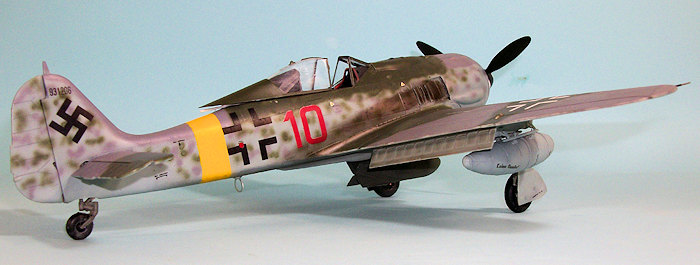 However,
there are good things to the kit too. It is the first Fw-190 kit to include the
underwing drop tanks, along with a full complement of the various ordnance
load-outs the type carried. Additionally, the BMW 801 engine is included, and
can be made up into a model of its own. Unfortunately, more than a few modelers
have discovered that the mount for the engine is fiddly enough that I have only
so far seen one completed model that had the cowling on over the engine in the
“opened up” configuration.
However,
there are good things to the kit too. It is the first Fw-190 kit to include the
underwing drop tanks, along with a full complement of the various ordnance
load-outs the type carried. Additionally, the BMW 801 engine is included, and
can be made up into a model of its own. Unfortunately, more than a few modelers
have discovered that the mount for the engine is fiddly enough that I have only
so far seen one completed model that had the cowling on over the engine in the
“opened up” configuration.
The kit provides both open and closed sliding canopies, which the Hasegawa kit doesn’t. There are two markings alternatives for SG 10 in the late war period. It should be noted that Eagle Editions has released two sheets of Fw-190F-8s for those who want something a bit more interesting.
| CONSTRUCTION |
The usual Revell instruction sheet leads to modelers making the usual mistakes associated with using Revell instruction sheets, but it is possible to figure things out.
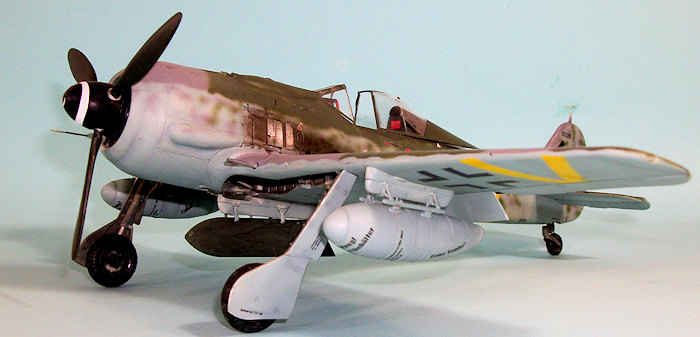 Overall,
everything fits and the separate control surfaces allow the model to be posed
more dynamically. The fuselage gun bay can be opened up to display the 13mm
weapons, but extra work will be needed there to provide adequate detail which
Revell didn’t put in. The cockpit isn’t all that detailed, but then once
installed it’s not all that visible anyway other than the seat, so all is well
there.
Overall,
everything fits and the separate control surfaces allow the model to be posed
more dynamically. The fuselage gun bay can be opened up to display the 13mm
weapons, but extra work will be needed there to provide adequate detail which
Revell didn’t put in. The cockpit isn’t all that detailed, but then once
installed it’s not all that visible anyway other than the seat, so all is well
there.
The problematic area is mounting the engine to the airframe. Revell chose to make the engine mounts close to “scale” thickness, which means they’re not all that strong and it is easy to misalign things and not know it until one tries to fit the cowling parts properly in the open position. If you’re determined to do that, you may want to get the issue of Model Air International in which Spencer Pollard successfully achieved this. The other alternative is to close up the cowling and slide it over the engine into position.
| COLORS & MARKINGS |
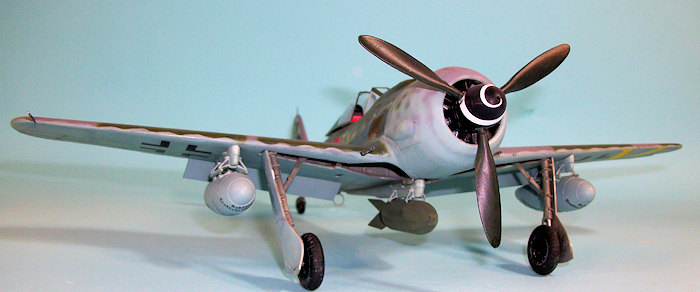 There are some
interesting camouflage schemes associated with the FW-190F-8, primarily the
winter schemes of white “scribble” over the airframe. There are photos of F-8s
with unpainted lower wings. Other than that, one’s options are fairly limited to
a factory scheme of 75/82 over 76 with varying amounts of dapple.
There are some
interesting camouflage schemes associated with the FW-190F-8, primarily the
winter schemes of white “scribble” over the airframe. There are photos of F-8s
with unpainted lower wings. Other than that, one’s options are fairly limited to
a factory scheme of 75/82 over 76 with varying amounts of dapple.
I used the kit decals in combination with a side number and swastika from another Fw-190 sheet in the decal dungeon. I also used stencil decals for the drop tanks from other kit sheets I have, since Revell did not see fit to include those on their sheet.
I gave the model a coat of clear flat, applied the heavy exhaust staining associated with the BMW 801 engine, and posed the flaps down and canopy open.
| CONCLUSIONS |
The kit is good value for money, and with a bit of extra effort can be turned into a real head-turner, as Spencer Pollard’s model demonstrates. The parts are there to turn the kit into an Fw-190A-8, so if one has decals in their collection, this is a good alternative to the Hasegawa for the later versions of the radial-powered fighter.
26 May 2016
Copyright ModelingMadness.com
Thanks to my billfold for the review copy.
If you would like your product reviewed fairly and fairly quickly, please contact the editor or see other details in the Note to Contributors.